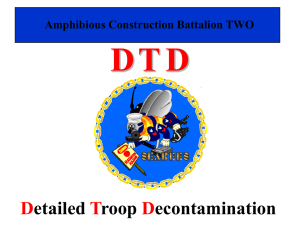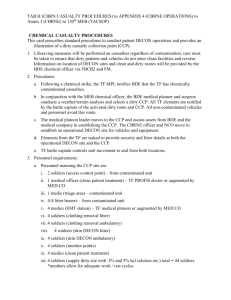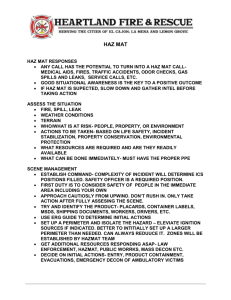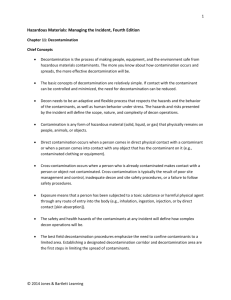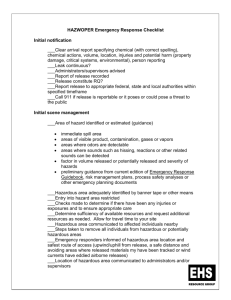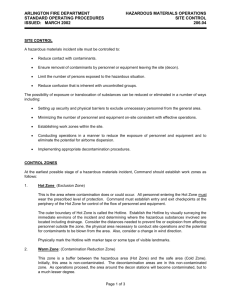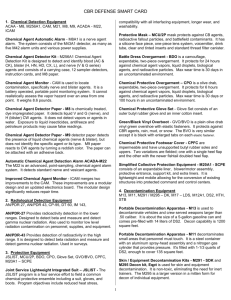Chapters 1 - on ENLISTMENT.US
advertisement
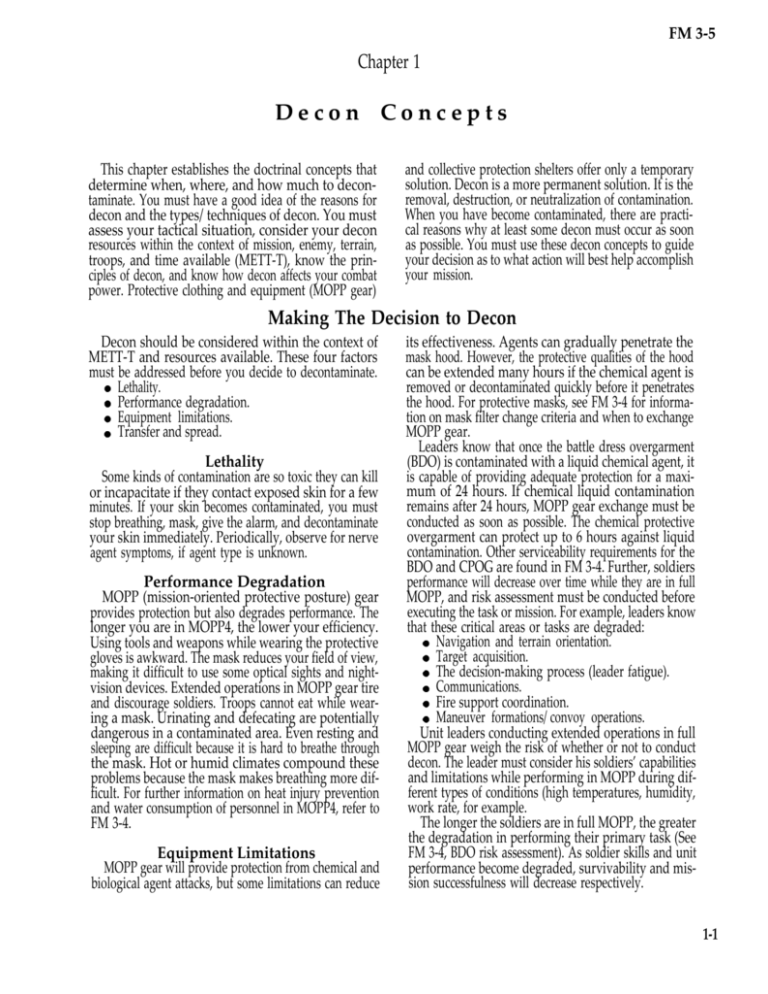
FM 3-5 Chapter 1 Decon Concepts This chapter establishes the doctrinal concepts that determine when, where, and how much to decontaminate. You must have a good idea of the reasons for decon and the types/techniques of decon. You must assess your tactical situation, consider your decon resources within the context of mission, enemy, terrain, troops, and time available (METT-T), know the principles of decon, and know how decon affects your combat power. Protective clothing and equipment (MOPP gear) and collective protection shelters offer only a temporary solution. Decon is a more permanent solution. It is the removal, destruction, or neutralization of contamination. When you have become contaminated, there are practical reasons why at least some decon must occur as soon as possible. You must use these decon concepts to guide your decision as to what action will best help accomplish your mission. Making The Decision to Decon Decon should be considered within the context of METT-T and resources available. These four factors must be addressed before you decide to decontaminate. Lethality. Performance degradation. Equipment limitations. Transfer and spread. Lethality Some kinds of contamination are so toxic they can kill or incapacitate if they contact exposed skin for a few minutes. If your skin becomes contaminated, you must stop breathing, mask, give the alarm, and decontaminate your skin immediately. Periodically, observe for nerve agent symptoms, if agent type is unknown. Performance Degradation MOPP (mission-oriented protective posture) gear provides protection but also degrades performance. The longer you are in MOPP4, the lower your efficiency. Using tools and weapons while wearing the protective gloves is awkward. The mask reduces your field of view, making it difficult to use some optical sights and nightvision devices. Extended operations in MOPP gear tire and discourage soldiers. Troops cannot eat while wearing a mask. Urinating and defecating are potentially dangerous in a contaminated area. Even resting and sleeping are difficult because it is hard to breathe through the mask. Hot or humid climates compound these problems because the mask makes breathing more difficult. For further information on heat injury prevention and water consumption of personnel in MOPP4, refer to FM 3-4. Equipment Limitations MOPP gear will provide protection from chemical and biological agent attacks, but some limitations can reduce its effectiveness. Agents can gradually penetrate the mask hood. However, the protective qualities of the hood can be extended many hours if the chemical agent is removed or decontaminated quickly before it penetrates the hood. For protective masks, see FM 3-4 for information on mask filter change criteria and when to exchange MOPP gear. Leaders know that once the battle dress overgarment (BDO) is contaminated with a liquid chemical agent, it is capable of providing adequate protection for a maximum of 24 hours. If chemical liquid contamination remains after 24 hours, MOPP gear exchange must be conducted as soon as possible. The chemical protective overgarment can protect up to 6 hours against liquid contamination. Other serviceability requirements for the BDO and CPOG are found in FM 3-4. Further, soldiers performance will decrease over time while they are in full MOPP, and risk assessment must be conducted before executing the task or mission. For example, leaders know that these critical areas or tasks are degraded: Navigation and terrain orientation. Target acquisition. The decision-making process (leader fatigue). Communications. Fire support coordination. Maneuver formations/convoy operations. Unit leaders conducting extended operations in full MOPP gear weigh the risk of whether or not to conduct decon. The leader must consider his soldiers’ capabilities and limitations while performing in MOPP during different types of conditions (high temperatures, humidity, work rate, for example. The longer the soldiers are in full MOPP, the greater the degradation in performing their primary task (See FM 3-4, BDO risk assessment). As soldier skills and unit performance become degraded, survivability and mission successfulness will decrease respectively. 1-1 FM 3-5 The contamination hazard will be reduced by conducting hasty decon and exchange of the MOPP gear. This will also provide temporary relief from MOPP and the reduction of risk during combat operations. The commander considers the time and resources needed to conduct decon versus the degradation caused by operating in full MOPP gear. The leader also understands that before ordering removal of protective masks, he must move his unit to a clean area and conduct unmasking procedures. After hasty decon, (MOPP gear exchange and vehicle washdown), the soldiers’ risk is reduced by: Decreasing the time personnel are exposed to chemical agents. Providing temporary relief from full MOPP. This aids in increasing units’ survivability on the battlefield because the MOPP encapsulation causes limitations that may result in conventional casualties (for example, heat stress in combat). Decreasing the risk of transfer and spreading of contamination. MOPP gear provides little direct protection from the hazards of radiological (rad) contamination, such as the radiation from fallout. But commanders may often decide to use MOPP gear for its indirect advantages. MOPP4 can prevent the inhalation of radioactive particles, keep contamination off skin, and greatly simplify decon. Although the danger from fallout is not immediate, the radiation may gradually build up to a dangerous level. Therefore, the contamination must be removed as soon as the mission allows. The protective mask falter elements will need to be replaced because of buildup of radioactive particles. Transfer and Spread You must avoid contamination as much as possible. Once a unit becomes contaminated with a chemical agent, quick or rapid decon is critical to prevent further spread or transfer of contamination onto a clean area or surface. This action may allow the unit to be in the lowest MOPP level possible and preserve its combat power. Principles of Decontamination The resources of manpower, time, and material are critical for the commander’s decision on how to sustain combat operations. The commander must apply two concepts — the use of these resources and his ability to sustain combat operations. He must know when, where, what and how to perform decon by following these four principles below: First, decontaminate as soon as possible. This is the most important principle of the four. Consider this principle before you consider any other. Contamination hazards force you into higher levels of MOPP and immediately begin to degrade your combat power. The sooner the contamination is removed, the sooner you can reduce MOPP levels and begin restoring combat power. Second, decontaminate only what is necessary. To survive and win on the contaminated battlefield, you cannot waste precious resources decontaminating everything. Decontaminate only what is necessary to continue your mission. This will help sustain your combat power. Consider the following factors when you decide whether decon will interfere with the mission or help you continue the mission: Mission – “tempo of battle.” Time available. Degree of contamination. Length of time you have been in MOPP4. Decon assets available. Third, decontaminate as far forward as possible (limit spread). Do not transport contaminated personnel and equipment away from your operational area if you can bring decon assets forward safely. This will keep your equipment on location, where it is needed, allow decon to begin earlier, and limit the spread of contamination to other areas. Fourth, decontaminate by priority. Clean important items of equipment first and less important items of equipment last. For instance, howitzers of an artillery battery get decontaminated before the ammunition carriers. Unit commanders decide which of their vehicles are most important to the unit’s mission. Battalion and brigade commanders decide which elements to first pull “off line” to decontaminate and/or decon during the reconstitution process. Division and corps commanders must set priorities and concentrate decon assets to best support the battle. Levels of Decontamination There are three levels of decon: immediate, operational, and thorough (see table 1-1). Immediate Decon: The aim of immediate decon is to minimize casualties, save lives and limit the spread of contamination. Immediate decon is carried out by individuals upon becoming contaminated. There are three 1-2 immediate decon techniques: skin decon, personal wipedown, and operator’s spraydown. Operational Decon: The aim of operational decon is to sustain operations, reduce the contact hazard and limit the spread of contamination to eliminate the necessity or reduce the duration of wearing MOPP gear. Operational decon is carried by individuals and/or units. It is FM 3-5 restricted to specific parts of operationally essential equipment/material and/or working areas, in order to minimize contact and transfer hazards and to sustain operations. Further decon may be required to reduce contamination to negligible risk levels. There are two operational decon techniques: vehicle washdown and MOPP gear exchange. Thorough Decon: The aim of thorough decon is to reduce or eliminate the need for individual protective clothing. Thorough decon is carried out by units with assistance from chemical units to reduce contamination on personnel, equipment/material, and/or working areas to the lowest possible level (negligible risk) to permit the reduction or removal of individual protective equipment and maintain operations with minimal degradation. This may include decontamination of terrain as required. There are three thorough decon techniques: detailed troop decon, detailed equipment decon, and detailed aircraft decon. The three levels of decon – immediate, operational, and thorough– are presented as part of this chapter to explain the seven standard decon techniques used for most decon operations (See Figure 1-1). Your chemical officer or NCO advises on efficient ways to conduct hasty or deliberate decon operations. For example, conducting decon operations might require the use of one or a combination of the seven decon techniques. Immediate Decon Immediate decon decon includes skin decon, personal wipedown, and operator’s spraydown. Skin Decon is a basic soldier survival skill. When chemical and toxic agents get on bare skin, you have an emergency. Some of these agents can kill if they remain on the skin for longer than a minute. The best technique for removing or neutralizing these agents is to use the M291 or M258A1 skin decon kit. Observe a soldier for symptoms after skin decon is conducted. Commanders must ensure soldiers are trained to execute this technique automatically, without waiting for orders. The CAM or M8 paper may be used initially to identify nerve or blister (H or G) type of agents (see TC 3-4-1). Personal Wipedown should begin immediately after skin exposure to liquid contamination or when exposure to liquid contamination is suspected. The wipedown removes or neutralizes contamination on the hood, mask, gloves, and personal weapon. For chemical and biological contamination, soldiers use skin decon kits. Using the CAM and M8/M9 paper (as described in equipment monitoring) allows you to decon only what is necessary and conserves decon resources and time. For radiological contamination, soldiers wipe the contamination off with a cloth or simply brush or shake it away. Operator’s Spraydown should begin right after finishing the personal wipedown. The spraydown removes or neutralizes contamination on the surfaces of the equipment that operators must frequently touch to perform their mission. For chemical and biological contamination, operators use onboard decon apparatuses like the M11 or M13. Operating the CAM or using M8/M9 paper will assist in determining what is contaminated. Again, conserve time and needed resources. For radiological contamination, brush or scrape the contamination away with whatever is at hand or flush with water and wipe. Operational Operational decon includes vehicle washdown and MOPP gear exchange. Operational decon allows a force to fight longer and sustain its mission while contaminated. It limits the transfer hazard by removing most of the gross contamination on equipment, and nearly all the contamination on soldiers. This speeds the weathering process and allows clean areas (people, equipment, and terrain) to stay clean. These techniques (see Chapter 3) do not guarantee conditions to safely allow unmasking on or near equip- 1-3 FM 3-5 These techniques . .(see Chapter 3) do not guarantee conditions to safely allow unmasking on or near equipment. But, soldiers may move upwind of “vapor dirty” equipment into a clean area or collective protection shelter. When soldiers have small concentrations of vapor hazards on themselves, they may move into hazardfree areas for temporarily unmasking however, unmasking procedures must be done before proceeding to a relief posture. Vehicle washdown can be executed using the concept of supported or unsupported operational decon. Vehicle washdown unsupported is executed by the contaminated unit (battalion or task force), using its own decon equipment and personnel. This process uses no external support or resources. Vehicle washdown supported is performed by the unit with support from a chemical company. The chemical company mission support priorities will be established by applicable operation orders (OPORD). The use of assets from a chemical unit to support hasty decon may occur when: The contaminated unit’s decon equipment and resources are unable to process their large number of contaminated vehicles in a timely manner. If the mission of the maneuver unit is critical and limited by time, the operational supported concept will speed the decon process. The contaminated unit does not have the equipment or their equipment is not serviceable. More information about this concept will be discussed in Chapter 4. MOPP gear exchange involves soldiers changing their contaminated MOPP gear for a clean set at the operational decon site. The squad or platoon is responsible for supervising and conducting its own MOPP gear exchange during hasty decon or when the unit commander authorizes it. After MOPP gear exchange, leaders must check for contamination and should continue monitoring when in a hazard-free area. Proper unmasking procedures must be followed after verifying the area is clean. Vehicle washdown involves soldiers of a contaminated unit using the M12A1 power driven decon apparatus (PDDA) or the M17 lightweight decon system (LDS) to conduct vehicle washdown. If decon assets are available and mission allows, it is most effective to conduct the vehicle washdown technique within one hour. However, if mission does not allow decon within one hour of exposure, the washdown will still be effective in removing gross contamination and limiting spread. However, soldiers’ degradation has to be considered when conducting operational decon after more than one hour of exposure. Operational decon maintains the unit’s survivability when the time or circumstances are critical for the overall tactical situation. Operational decon should be done as soon as it is practical. Operational decon — Prolongs the combat capability of the unit. 1-4 FM 3-5 Assists contaminated unit during the conduct of passage of line. Limits the spread and transfer of contamination during rearming, refueling and resupplying operations. Prolongs the effectiveness of combat crews. Increases maneuverability of the unit. Allows the soldiers to move into a clear area and conduct unmasking procedures for temporary relief. The longer you wait to remove or neutralize contamination, the harder it will be to do so. Also, the longer you wait, the greater the opportunity for the chemical agents to spread and make contamination problems worse. Thorough Thorough decon includes detailed troop decon and detailed equipment/aircraft decon. Detailed troop decon (DTD) is the process of decontaminating individual fighting equipment to negligible risk levels. Soldiers will remove contaminated MOPP gear to include their protective masks. Protective masks will be decontaminated and personal equipment will be monitored for decon effectiveness. This reduces MOPP levels for extended periods. The contaminated unit conducts deliberate troop decon with some technical assistance from the chemical unit or unit chemical personnel. Detailed equipment/aircraft decon (DED/DAD) is the process of removing or neutralizing contamination on interior and exterior surfaces of unit equipment to negligible risk levels to allow MOPP level reduction for extended periods. The chemical unit performs thorough equipment decon with assistance from the contaminated unit. Thorough decon operations reduce contamination to negligible risk levels (See Negligible Risk, Introduction). They restore combat power by removing nearly all contamination from unit and individual equipment so troops can operate equipment safely for extended periods at reduced MOPP levels. A small risk from residual contamination remains, so periodic contamination checks must be made after this operation. Thorough decon could occur: After combat operation. During reconstitution. After a passage of lines. These three situations present different consideration for management of supplies, resources, and planning of decon operations. Thorough decon after combat operations: Consider this situation: A mission capable unit (for example, maneuver battalion) has been contaminated but needs all its available combat power for an upcoming high priority mission. However, the contamination does not allow the unit to perform at 100 percent of its capability because of MOPP degradation. At this point, the decision is made to support the contaminated unit with thorough decon to restore the combat power by lowering the contamination to a negligible risk. Such operations will not require extensive support from other combat support (CS) or combat service support (CSS) units. The decision to support this unit/battalion with thorough decon operations, in this situation, will probably be made at division level (for example, division owns the needed combat support asset – chemical company). Theater/Corps chemical units may also assist a divisional chemical company, upon request, if the tactical situation allows it. Consideration may be given to decontaminating only the combat systems, if time is critical. See combat operations decon process (Table 4-1). Once the contaminated unit’s contamination is reduced to a negligible risk, the unit can proceed to combat operations without transferring or spreading contamination. Planners (see Table 4-1, page 4-4), determine the amount of time and resources needed to execute decon operations. Planners factor the time required for decon into the time a unit will need to prepare for either an offensive or defensive operation. Thorough decon during reconstitution Reconstitution consists of reorganization, assessment and regeneration. Thorough decon operations are conducted during the reorganization and/or regeneration process. Operations that support regeneration of combat power may involve support to units that are contaminated. The contaminated units may not be capable of providing unit personnel to the detailed equipment decon line because of combat losses. To minimize the transfer or spread of contamination, thorough decon will occur before the sustainment activities (that is, manning, suppling, maintaining). Additional personnel should be provided as needed to man decon lines and operate vehicles to accomplish thorough decon. This decon process will occur forward from the designated assembly area before the contaminated unit go through the large scale replacement of personnel, equipment, and supplies. Corps chemical units, assisted by division chemical units, will support reconstitution operations. Thorough decon after passage of lines: Consider for this situation a passage of lines by a combat unit under enemy pressure that has encountered contamination during its movement. The principles “decon as far forward as possible” and “decontaminate as soon as possible” apply in this case. The division (or higher) makes the decision to support the unit with operational decon forward to limit the spread of contamination and to limit unit degradation. The contaminated unit identifies what equipment is contaminated and sends those vehicles to a predesignated passage point. Support is made available at that location for the unit to go through operational decon to remove gross contamination. 1-5 FM 3-5 Once this operation is completed, the contaminated unit proceeds to thorough decon operations without spreading contamination. Prior to arrival at the tactical assembly area, the contaminated unit will proceed through a thorough decon. Corps chemical units may support operational and thorough decon operations, and divisional and regimental chemical companies assist in the operational or thorough decon missions. Decontamination in Combat When a force is contaminated, its combat power drops (as shown in Figure 1-2). The most significant reason for this drop is the performance degradation caused by operating in higher levels of MOPP. Decon can neutralize the contamination and restore the combat power. To survive, individual soldiers must be the first to react to contamination. The decon techniques that they can use are extremely important because they must be applied within minutes of contamination. To sustain their combat power and to continue their mission, elements of the contaminated unit should follow up on the decon done by individual soldiers with operational decon operations. For some contaminants, this may be all that is required to restore combat power. Finally, for persistent agent contamination combat power is restored using thorough decon operations. Operational and thorough decon are managed at unit level and require detailed planning in much the same way as a hasty or deliberate attack or river crossing. Figure 1-2 shows how the drop in combat power is slowed by a series of decon actions. First, soldiers use immediate decon to survive the attack and stop agent from penetrating the surfaces that must be constantly touched. But, this does not affect the slower reduction of combat potential caused by the performance degradation of MOPP4. By attacking the contamination early, the decon is very effective. Next, elements of the unit use operational decon operations to reduce the overall levels of contamination and limit its spread. Areas free of contamination are identified and protected. Soldiers may begin to briefly restore their combat power because they can move to clean areas, rest, and eat in reduced MOPP levels, In some cases, this operational decon may be effective enough that after some weathering, MOPP levels can be reduced for extended periods without further decon. Thorough decon operations remove sufficient amounts of contamination to allow soldiers to safely operate the equipment at reduced MOPP levels for extended periods. It requires that the unit be taken out of battle temporarily, but when it is finished decontaminating, the unit’s combat power is restored. Generally, it will no longer need to operate in full MOPP4. This progression of decon techniques will often be more effective. It uses fewest resources at proper times to be effective and provides long-term benefits that can allow soldiers to lower MOPP levels much earlier. 1-6 Here is an example of how a self-propelled artillery battery might decontaminate while continuing its fire support mission. You command a 155mm self-propelled howitzer battery that has just been hit with rocket-delivered persistent nerve agent. Your personnel take good defensive measures during the attack. They go to MOPP4 and take cover; only a few personnel and pieces of equipment are unprotected. Most of the contamination is on the outside of the guns and vehicles. Only a few soldiers need to conduct skin decon. You quickly try to continue your mission and neutralize or destroy the enemy. Your soldiers are well-trained, and at their first opportunity they begin personal wipedown and operator’s spraydown (principle 1 – decontaminate as soon as possible). They conduct personal wipedown and use their onboard decon apparatuses to spray down control surfaces or equipment that must be touched. This takes just a few minutes. You continue providing fire support in MOPP4 and move when necessary. The temperature is 55° Fahrenheit (13° Celsius) and humidity is low. Your soldiers stay in MOPP4 for several hours. Their fighting capability is growing weaker, but there have not been any heat casualties yet. Your rigorous training in MOPP gear during the past 12 months is paying off. However, the response times from receipt of fire mission to rounds leaving the tubes is getting longer. Your soldiers have not eaten in more than 12 hours. You know your combat power will continue to drop the longer you stay in MOPP4. You decide to do more decon so that you can get temporary relief from MOPP4. You want to sustain your power and continue your fire support mission. You request decon support from your battalion. The battalion directs you to conduct operational decon en route to your alternate position (principles 2 and 3 – decontaminate only what is necessary and decontaminate as far forward as possible). You have 2-1/2 hours to complete this and be at your next position ready to fire. Your alternate position is a 20-minute road march away. The decon site, en route to your position, is 10 minutes away. You immediately send an advance party to the operational decon site. They meet the battalion decon crew with the battalion PDDE crew and set up the site. The PDDE crew sets up and runs the vehicle washdown area and the PDDE. The advance party assists the PDDE crew and prepares the MOPP gear exchange area. A FM 3-5 battery supply vehicle meets the advance party at the decon sites. You rotate one firing platoon at a time through the decon site so most of the battery can maintain fire support. The guns are the first vehicles to be washed down and their crews are the first to go through the MOPP gear exchange because they are the most important elements in the battery (principle 4 — decontaminate by priority). You finish operational decon and are in position, ready to fire-within the directed times. Of course, your soldiers are still masked because there is still a vapor hazard from the contamination left on the guns and vehicles. Your advance party has checked your new position and found it clear of contamination. As you move into the position, you receive orders from battalion to conduct ammunition resupply. Your sections begin improving their positions. You direct gun crews one and two to leave just one soldier on each gun and send the rest of the two crews 20 meters upwind of the guns. This area is checked again and found clear of contamination. Because your battery conducted a good MOPP gear exchange, there is little, if any, contamination on the soldiers. The senior soldier directs unmasking procedures on two of the crew members and has one soldier to monitor those soldiers for agent poisoning signs. The two gun crews can now eat and get relief from the mask for short periods of time. The senior soldier ensures that the wind direction is constantly checked so that the unmasked soldiers remain upwind of their “vapor dirty” guns and equipment. Soldiers remaining on the guns and in the vehicles stay masked because the equipment is still contaminated and poses a vapor hazard. Consequently, the soldiers in sections one and two remask before they return to their guns. The soldiers in the other sections are rotated through the temporary relief area in the same way. Ammunition resupply and position improvement continue. 1-7

